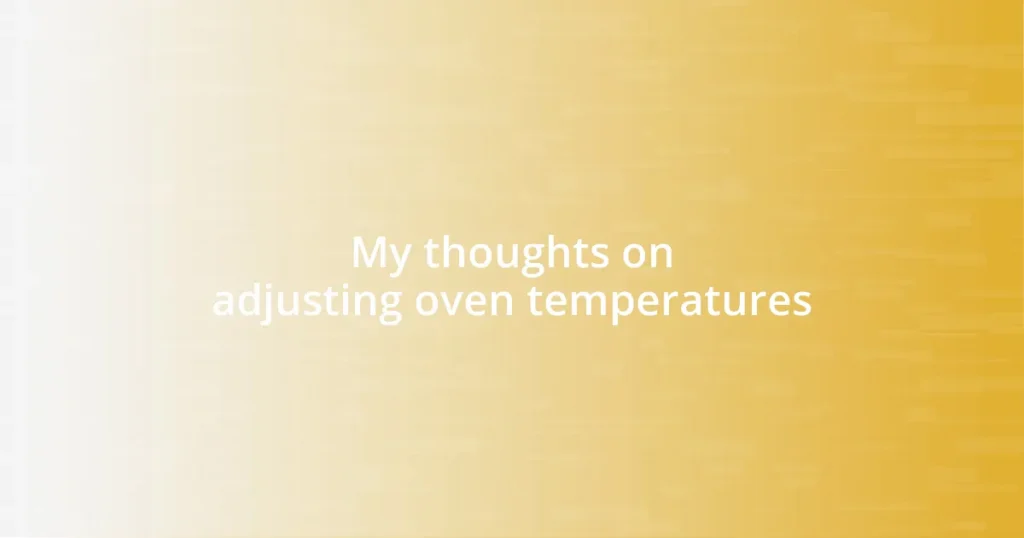Key takeaways:
- Understanding your oven’s unique temperature settings is crucial for successful cooking and baking outcomes.
- Precise oven temperatures affect cooking time, texture, flavor, and food safety—miscalculations can lead to undesirable results.
- Adjustments may be necessary based on ingredient reactions, oven variability, and seasonal changes to achieve optimal dishes.
- Investing in an oven thermometer ensures accuracy, enhancing the baking experience and preventing common mistakes.

Understanding oven temperature settings
Understanding oven temperature settings can be quite a journey. I remember the first time I attempted to bake a soufflé—never again will I forget the tension in the air as I anxiously peeked through the oven window, heart racing. That moment taught me just how crucial it is to grasp temperature settings; they can make or break a dish!
Ovens typically have various temperature settings, but what do they really mean? For instance, preheating to 350°F is common for baking, but if your oven runs hot or cold, it could lead to uneven results. Has that ever happened to you? I’ve had cakes rise beautifully only to collapse, all because I didn’t account for my oven’s quirks.
It’s essential to familiarize yourself with your specific oven—every appliance has its personality! I often recommend investing in an oven thermometer to ensure accuracy. After all, who wants a beautifully styled dinner only to find it cooked unevenly? Understanding these nuances can transform your cooking experience from frustrating to joyful!

Why oven temperatures matter
Oven temperatures matter more than most people realize. I’ve learned that precise temperatures can be the difference between a perfectly cooked roast and a dry piece of meat. For instance, I once forgot to adjust my oven temperature while trying a new recipe. The result? A disastrous loaf of bread that was as hard as a brick! It was a harsh reminder that temperature isn’t just a number; it’s essential to the chemistry of cooking.
Here are a few key reasons why oven temperatures play such a vital role:
- Cooking Time: Different dishes require specific temperatures to cook properly. A too-high or too-low temperature can ruin the timing.
- Texture and Flavor: Adjusting the temperature impacts the Maillard reaction, which is crucial for browning and flavor development.
- Food Safety: Precise temperatures ensure that foods, especially proteins, reach safe internal temperatures to prevent foodborne illnesses.
- Even Cooking: Miscalculating temperatures can lead to uneven cooking—think burnt edges with raw centers!
- Baking Science: Baking is a science, and correct temperatures ensure the right reactions for structure—like activating yeast in bread.
I can’t stress enough how important it is to respect the numbers!

Common reasons for temperature adjustments
It’s fascinating how frequently we need to adjust oven temperatures based on what we’re cooking. From experience, I’ve found that different ingredients react uniquely to temperature changes. For instance, when I bake cookies, lowering the temperature slightly can result in softer, chewier treats. But if I’m roasting vegetables, a higher setting creates that delightful caramelization that brings out their natural sweetness. Isn’t it amazing how such small tweaks can unleash the full potential of our ingredients?
Another reason for adjusting the temperature is due to oven differences, even between models of the same brand! I once used my mom’s oven and was surprised to find that it cooks significantly hotter than mine. I had to lower the temperature by 25°F for my beloved lasagna recipe, but the result was worth it—perfectly bubbly and cheesy. Have you ever encountered something similar with a friend’s kitchen? It’s these little surprises that remind us that mastering an oven means knowing it personally.
Finally, seasonal changes can also necessitate temperature adjustments. In the winter, I often find myself cranking up the heat a bit for bread, as my kitchen tends to be cooler. On the other hand, during hot summer months, reducing the heat can help avoid the dreaded dry loaf. I find myself constantly adjusting based on both the environment and the specific dish at hand. It’s quite the balancing act, isn’t it?
| Reason for Adjustment | Description |
|---|---|
| Ingredient Reactivity | Different ingredients respond to heat differently, requiring adjustments for optimal outcomes. |
| Oven Variability | Oven models and their quirks may necessitate temperature changes for consistent results. |
| Seasonal Changes | Temperature adjustments might be needed based on the season to accommodate cooking conditions. |

How to properly adjust temperatures
When adjusting oven temperatures, it’s essential to consider both the dish and the desired outcome. For example, I remember a time when I was preparing a delicate soufflé. I instinctively dropped the temperature slightly mid-way through baking because I noticed some browning on top. That little change resulted in a light, airy treat instead of a collapsed disappointment. Isn’t it incredible how just a minor adjustment can turn a potential flop into a culinary triumph?
Another key aspect of adjusting temperatures is understanding your oven’s quirks. I can’t tell you how many times I’ve been caught off guard by my oven’s personality. Whether it’s retaining heat like a cozy blanket or cooling down faster than I anticipated, I’ve learned to account for its behavior when I cook. Have you ever had to remind yourself to adjust your baking time because your oven just runs hot? Patience and observation really are your best friends in the kitchen.
Lastly, keeping an eye on your dish while it cooks can reveal when it’s the right moment to tweak the temperature. I often find myself peeking through the oven window—there’s something about seeing that gorgeous crust form on a pie or that golden glow of roasted chicken that feels rewarding. Adjusting on the fly has helped me salvage many meals. After all, isn’t cooking a delicious dance of instinct, observation, and a pinch of courage?

Impact of altitude on baking
Altitude plays a surprisingly crucial role in baking, and it took me some time to fully appreciate its impact. Living at a higher elevation once meant that everything I baked seemed to rise like the heavens, but not always in a good way. Have you ever pulled a cake from the oven, only to have it collapse as soon as it hits the counter? I have, and it’s disheartening. This phenomenon can be attributed to lower air pressure at high altitudes, which causes baked goods to rise too quickly and then fall flat, leaving a dense texture instead of the fluffy delight we hope for.
Additionally, I learned how dehydration can alter baking outcomes when I moved to a mountainous area. The drier air means moisture evaporates faster, affecting not only the baking process but also the final product. I recall making muffins that turned out dry and crumbly after introducing new recipes without considering the altitude. It was a lesson in adapting my liquid ingredients. I now add a splash more milk or water, and it makes all the difference. Have you ever underestimated the role moisture plays in achieving that perfect crumb?
Finally, adjusting both baking time and temperature is crucial when dealing with high altitude. I remember struggling with brown sugar cookies that baked too quickly and turned out like hard little discs instead of the chewy treats I desired. Adding an extra five degrees to the temperature and decreasing baking time by a couple of minutes worked wonders. It’s a reminder that, high up in the mountains, you don’t just have to factor in your ingredients and your oven; altitude definitely requires our utmost attention. Do you think you’d remember to make such adjustments if you were to bake at a higher elevation? I know I won’t forget again!

Tips for consistent baking results
When it comes to achieving consistent baking results, preheating your oven accurately cannot be overstated. I vividly recall baking a batch of cookies on a whim without waiting for the oven to reach the proper temperature. The outcome was a sad, flat mess instead of the thick, chewy treats I envisioned. Have you ever faced something similar, where impatience cost you that perfect bake? Taking the time to let your oven warm up fully really sets the stage for success.
Another essential tip I’ve learned is to invest in an oven thermometer. Trust me, this little tool is a game changer! My oven’s built-in thermostat can be misleading—it once read 25 degrees cooler than what I set. Can you imagine a cake rising in a lukewarm environment? Incorporating that thermometer allowed me to adjust my baking times confidently. There’s nothing like the security of knowing you’re working with the exact temperature you intended.
Lastly, I’ve found that rotating my pans halfway through baking greatly improves consistency, especially with baked goods like cakes and breads. I recall a time when one side of my cake was beautifully golden while the other was a sad pale shadow. It reminded me that even with meticulous temperature control, sometimes a little movement is necessary to ensure even baking. Have you tried this technique? It’s a simple change that can elevate your baking game and help you achieve those perfectly baked results every time.

Using a thermometer for accuracy
Using a thermometer for accuracy is a crucial step that many bakers might overlook. I remember when I decided to bake a delicate soufflé, believing my oven was perfectly preheated. To my dismay, it turned out half-cooked because my oven’s built-in gauge was off by nearly 30 degrees! Have you ever experienced that sinking feeling when your hard work doesn’t pay off due to something so easily preventable?
I always keep a reliable oven thermometer handy now. The first time I checked my ovens against it, I was shocked. I realized that even slight discrepancies could ruin my baked goods. The sense of reassurance I feel when I use my thermometer is invaluable—it’s a small investment for a big payoff. Wouldn’t it feel great to have that kind of confidence every time you bake?
When I bake for friends or family, I make it a point to share my thermometer tip with them. I’ve seen the joy on their faces when they achieve perfectly risen cakes and cookies, leaving behind that old fear of baking disasters. It’s like handing someone the secret to success! Who knew something so simple could make such a profound difference in our baking journeys?















